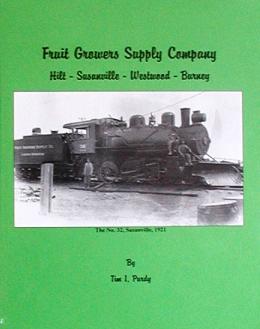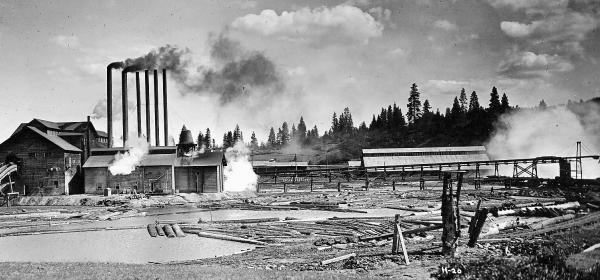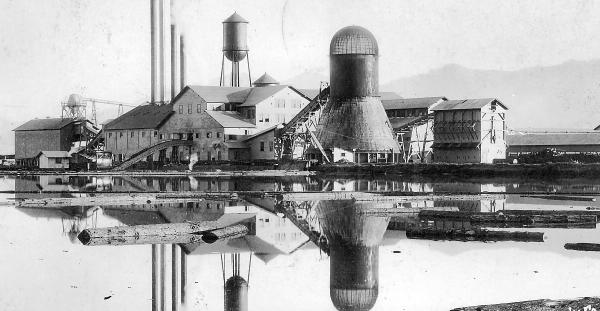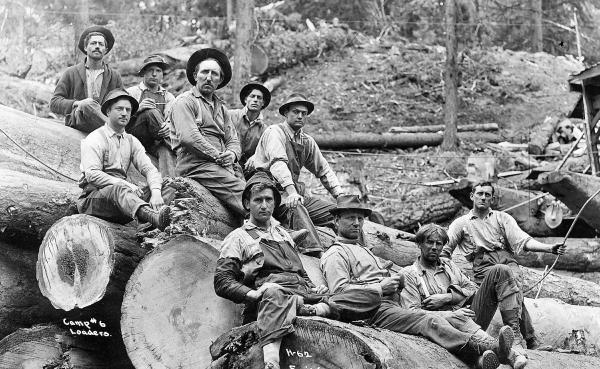
| HOME |
| Eagle Lake |
| Lassen Almanac |
| Susanville |
| Fruit Growers |
| Other Titles |
| Lake Almanor |
| Lassen High |
| Lassen VNP |
| Red River Lumber |
| Search |
| Archive |
| Research Services |
| Links |
Exploring Lassen County's Past and more . . .
|
Fruit Growers Supply Company By Tim I. Purdy 8x11; 164 pages, hardcover, ISBN: 0938373-19-6, Price $39.95 Sunkist & The Wooden Box "Through the first half of the 20th century the piece of furniture found most often in a newlywed's home or a college student's dorm wasn't really a piece of furniture. It was a wooden box. Turned on its side it held books, knickknacks, canned goods and spices. Covered with cloth it was topped with lamps, flowers and photographs . . . These wooden boxes, now pieces of history were some of the United States first recyclables. Before they found their way into the nation's homes, they were used to ship the nations produce. One of the most prominent producers of these wooden boxes, were surprisingly a group of California citrus growers." And so the story begins with the origin of the California citrus history to the formation of one of the most succesful cooperative marketing associations--The California Fruit Growers Exchange, known simply today as Sunkist. In 1907, the year the famous trademark Sunkist name was coined, the citrus growers were faced with a lumber shortage of boxes. Prices soared from 12 to 23 cents per box! The box shortage combined with inflated prices, prompted the Exchange to seek alternatives for an adequate supply of boxes. The Exchange formed a separate company to purchase supplies for its growers, and primarily for boxes. On October 5, 1907 the Fruit Growers Supply Company was incorporated. Fruit Growers first task was to secure boxes for the growers at a reasonable price, which they did sort of. It is from there this work explores Fruit Growers' Northern California logging and sawmill operations, along with changes in the citrus industry that led to the conversion from wood to cardboard in 1955.
Hilt - The First & Last Hilt located two miles south of the Oregon border in Siskiyou County, was Fruit Growers smallest sawmill operation, but operated the longest, for 62 years closing in 1973. It was Hilt how Fruit Growers entered into the lumber business and not necessarily by choice. The Northern California Lumber Co. owned a mill at Hilt. The Company had financial problems and Fruit Growers loaned them money in return for a supply of boxes. In 1910 the Northern California Lumber was on the verge of bankruptcy and forced Fruit Growers to foreclosed upon the Company. Once Fruit Growers took over, it also made it the owner of a company town, a unique one too, though it has disappeared like its sawmills. In addition, Fruit Growers was presented with the challenge of logging the rugged Siskiyou Mountains surrounding Hilt.
Susanville - A Fruit Growers Original Distinct of all of its operations was Susanville, in Lassen County , the only mill designed by Fruit Growers. A severe lumber shortage created by World War I and the successful advertising campaign of the Sunkist name required to Fruit Growers to expand its lumber interest. Exchange growers needed 14.8 million boxes compared 6.6 million boxes when Fruit Growers was established. In 1919 Fruit Growers purchased the Collins Tract in western Lassen County that contained a billion board feet of timber, and thus the Lassen Operation was established. In 1922 Fruit Growers was high bidder of the Pine Creek Unit Timber Sale for an additional billion board feet of timber. The Lassen Operation unfolds from bonds to box covers, railroad logging camps to logging trucks, to the planned conversion of mill to a paper pulp plant in the 1950s.
Westwood & Burney In 1940 the citrus industry continued to expand and the Exchange now required 40 million boxes annually. That factor combined with critical demands on the lumber market with World War II forced Fruit Growers to seek additional timber. They bought Red River Lumber Company's 81,000 acre Burney Tract and its town of Westwood . But changes were on the horizon with growers experimenting with cardboard boxes. Fruit Growers sought an alternative container Craveneer in 1954. That experiment proved futile and in 1955 the citrus industry converted to cardboard and the wooden box retired. Available from your local bookseller or direct from Lahontan Images, P.O. Box 1592 , Susanville , CA 96130 ($39.95 plus $3.95 shipping) |
Web Visits:
Last Updated: November 21, 2014
Report web site problems to Attn: Web Coordinator



